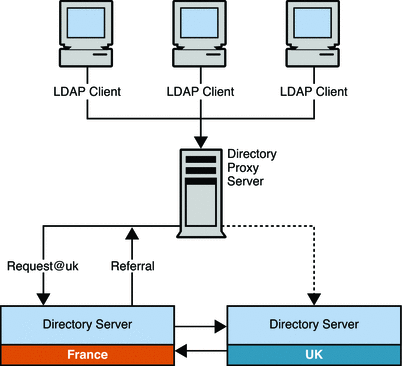Using Referrals For Distribution
A referral is information returned by a server that tells a client application which server to contact to proceed with an operation request. If you do not use Directory Proxy Server to manage distribution logic, you must define the relationships between distributed data in another way. One way to define relationships is using referrals.
Directory Server supports three ways of configuring how and when referrals are returned:
-
Default referrals. The directory returns a default referral when a client application presents a DN for which the server does not have a matching suffix.
-
Suffix referrals. When an entire suffix has been taken offline for maintenance or security reasons, the server returns the referrals defined by that suffix. Read-only replicas of a suffix also return referrals to the master server when a client requests a write operation.
-
Smart referrals. These referrals are stored on entries within the directory. Smart referrals point to Directory Servers that have knowledge of the subtree whose DN matches the DN of the entry that contains the smart referral.
The following figure illustrates how referrals are used to direct clients from the UK to the appropriate server in a global topology. In this scenario, the client application must be able to connect to all the servers in the topology (at the TCP/IP level), to enable it to follow the referral.
Figure 10–14 Using Referrals to Direct Clients to a Specific Server

Using Directory Proxy Server With Referrals
You can use Directory Proxy Server in conjunction with the referral mechanism to achieve the same result. The advantage of using Directory Proxy Server in this regard is that the load and complexity of client applications is reduced. Client applications are only aware of the Directory Proxy Server URL. If the distribution logic is changed, for any reason, this change is transparent to client applications.
The following figure illustrates how the scenario described previously can be simplified with the use of Directory Proxy Server. Client applications always connect to the Proxy Server, which handles the referrals itself.
Figure 10–15 Using Directory Proxy Server With Referrals

- © 2010, Oracle Corporation and/or its affiliates
